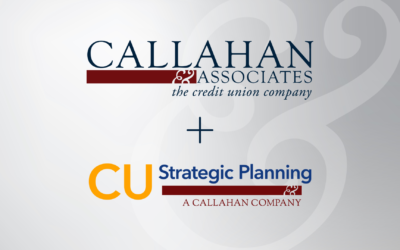Key Results from Sustainable Business Strategy
In the first quarter of 2022, a dozen BCU ($5.4B, Vernon Hills, IL) team members participated in Sustainable Business Strategy, a virtual-learning experience offered by Callahan & Associates in collaboration with Harvard Business School Online.
The program was created to help credit union decision-makers learn new contexts and mindsets for being truly purpose-driven and values-based. BCU’s participation led the credit union to:
- Reduce NSF fees to better serve members
- Form a financial wellbeing CUSO to better serve community needs
- Create a fund to help employees experiencing hardship.
Here, Jill Sammons, Senior Vice President Marketing, Well-being & Wealth Advisors for BCU, shares more about why the credit union decided to participate and how this shift toward a purpose-driven mindset has helped BCU drive sustainable growth while expanding operations to benefit members.
Why did BCU decide to participate in this program?
JS: At BCU, our goal is to empower members to find financial freedom. That means providing everything they need to take control of their finances and feel less stressed about money throughout each phase of life. That’s the idea behind our “To empower people to discover financial freedom” tagline and overall brand.
To ensure all employees understood our purpose, we surveyed them. Responses showed employees understood the meaning behind the credit union’s brand; however, they sometimes struggled to understand how the work they did day in and day out contributed to BCU’s purpose and mission.
Our team needed help connecting the dots and this program provided that. We also wanted this to be a group experience that could be shared, so we decided to have a dozen participants.
How were individual participants selected?
JS: We identified high-performing individuals to create a private cohort of cross-functional, mid-level leaders from finance, marketing, consumer lending, deposit products, and more. Employees in different time zones participated together, and team members who rarely interacted — even a pair as unlikely as the director of creative communications and the director of finance — established great relationships.
At the same time, four executive leaders participated in a mixed cohort with other credit unions to glean insights from others.
The two groups took the course in parallel, kicking off the experience in the first quarter of 2022. When the dozen participants regrouped for the final debrief, they were able to identify takeaways to immediately implement.
Which ideas were implemented immediately and what was the impact on members?
JS: There were several. One immediate action was analyzing and significantly reducing our non-sufficient funds and overdraft protection fees. Those decisions were directly correlated to the learnings from this course and have positively impacted our members.
Another action was expanding Life.Money.You. into a CUSO. We were in the early stages of forming an LLC and needed to gain consensus internally about separating our financial wellbeing work to have a greater impact, especially in underserved communities. We had offered financial wellbeing tools and resources to members under the Life.Money.You. brand for a decade. Convincing the board and leadership team that offering the program to non-members would benefit the community while supporting the financial stability and long-term performance of the organization was critical.
And last, but not least, BCU created a “GenerUs Fund” to allow employees to make small contributions to help their colleagues out of hardships. Employees can make $1 or $2 donations via payroll deduction or one-time gifts via digital banking. We talk about being purpose-driven, and this fund gives employees a tangible sense of purpose. Their small donation can have a huge impact on someone else. Just like we want to help people find financial peace, we want to help our employees thrive.
How else has participating in the course benefited your credit union?
JS: There are more voices in the room now pushing the credit union to have purpose-driven conversations and identify sustainable business opportunities. It’s not a coincidence that more of us are now asking how we grow in a scalable way without losing the internal culture and high-touch business practices we’re known for, it’s a direct result of our participation in this course.
In addition to serving six local communities in Illinois and Wisconsin, BCU serves a number of employee groups, and does a lot of business in Puerto Rico. Plagued by frequent hurricanes, our Puerto Rico headquarters has triple redundancy with solar power, generators, and water-preservation techniques. That came in handy when Hurricane Fiona made landfall as a Category 4 hurricane. As one of the few places with power in the aftermath, our employees used the BCU facility to charge cell phones and even do laundry as they served members. We were literally a beacon on the island during that time.
These sustainability efforts not only help our members, community, and employees, they make business sense, too. That’s a key teaching featured in Sustainable Business Strategy, the virtual-learning experience Callahan & Associates offers in collaboration with Harvard Business School Online.
There was this huge ‘aha’ moment when I saw the slide showing how you can do good in the world for people and do well financially for your organization.
What are BCU’s future plans? Any advice for other credit unions?
JS: We plan to send more employees through Sustainable Business Strategy in the future and see courses like this as a solid investment overall.
Aligning teams around sustainable business strategy can also help employees find their purpose and increase engagement. That’s a major advantage when recruiting and retaining talent is challenging.
How much do we really implement from a conference that a single person attends? A cohort-style experience like this one allowed our team to talk interactively about purpose and how to make an impact on the communities we serve.
For roughly the cost of sending an individual to an in-person conference, this virtual experience provides an opportunity for employees from all over the country to participate together over an extended time. The bonding, relationship-building and shared learning are invaluable.
This course is an investment with a strong ROI. You can’t go wrong by participating.
More Blogs
Callahan & Associates and CU Strategic Planning Combine To Increase Credit Union Impact
Callahan & Associates and CU Strategic Planning proudly announce their strategic alliance, driven by a shared vision to empower credit unions to make a meaningful impact on their members and communities.
Insights And Advice For Credit Union Leaders
Are you new to a leadership role or preparing for one? Are you focused on empowering future leaders? Are you a veteran leader looking to be inspired? We recently asked new and established leaders what it means to embrace different leadership styles, encourage culture changes, and what advice they have for the next generation of leaders.
5 Governance Tips for Credit Union Boards
Insights From Callahan Consultant, Chris Howard There’s a growing — albeit misguided — distrust of credit unions today, making effective governance more important than ever … and harder than ever. At its core, good governance is fairly simple, although never...
15 Key Ratios Every Credit Union Board Should Know
There are thousands of data points you can share with your board about your credit union’s performance, the industry, and the economy. The challenge is identifying which key ratios are most important to your credit union. If you’re looking for a list of key ratios and...
Why Great Lakes CU Is Betting Big On Partnerships
Last week, Callahan & Associates hosted the inaugural installment in its "A Conversation With..." webinar series, featuring Great Lakes Credit Union CEO Steve Bugg. In the exclusive conversation, Bugg emphasized the value partnerships can bring to the industry and...
Browse 5300 Call Reports With Ease.
Every CU 5300 Call Report – Instantly And Seamlessly. If your goal is to reach more credit unions with your products and services, you likely know all too well how long it takes to pull 5300 Call Reports for dozens of prospects to fuel your sales pipeline and...
How Sales Teams Work More Efficiently In Peer Suite
Is your team spending countless hours manually pulling reports and compiling data for your credit union prospects? Are you looking for a more efficient way to collaborate with your team and onboard new members? Callahan’s Peer Suite helps credit union suppliers...
Ultimate Benchmarking Guide For Credit Unions
What Is Benchmarking? Benchmarking is the interpretation and analysis of financial information in order to make direct performance comparisons to other credit unions, banks, and customized peer groups. It enables a credit union to track internal goals, identify...
How Interra Is Advancing Its Purpose Journey
Several years ago, the five-member executive team of Interra Credit Union ($1.7B, Goshen, IN) participated in a virtual learning experience from Callahan & Associates offered in collaboration with Harvard Business School Online.
3 Peer Group Types That Go Beyond Asset Size
While benchmarking your performance against asset-based peer groups has value, relying strictly on asset size for peer group analysis can skew your benchmarks by including credit unions that don’t share much in common with your institution. Just take a look at this...










